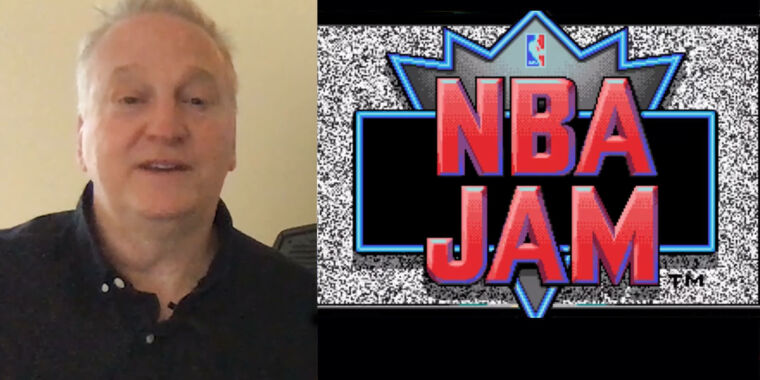
How did NBA Jam overcome a rocky launch and become one of the arcade era's all-time biggest hits? How did its developers move past a serious "digitization" screw-up? And where's the legendary original version featuring Michael Jordan and Ken Griffey, Jr?
On the eve of NBA Jam's latest home release—this time as an Arcade1Up cabinet (Best Buy, Walmart) featuring the series' first three arcade versions—we asked series lead programmer and designer Mark Turmell to join us from his home to answer these questions and more. The result is our most "on-fire" War Stories video yet, complete with original development footage provided by Turmell himself.
“Geeking out on digitized graphics”
As he explains in our interview, Turmell's game development history began with early consoles and home computers before he "shifted to the coin-op business" in 1989 with Williams, a Chicago arcade game and pinball manufacturer. (Two years later, the company's arcade division was re-branded "Midway," since Williams had bought Bally/Midway in 1988.) Shortly after his hire, the company began focusing on a trend that would eventually define many of its hits: "We were geeking out on the digitized graphics concept, the new technology, if you will," Turmell says.
But that meant figuring out a whole new way to represent video game characters, and Turmell explains some of the biggest development headaches that came as a result. In one example, he describes a pivotal video-capture session that revolved around actors playing basketball in front of a blue screen. Uniforms were supposed to arrive in a bland, gray color, but "the uniforms came in and they were blue," Turmell says. "We had no time to repaint. We were paying for studio time." The development team had to carve "every single frame" by hand to import them into the game, instead of neatly blocking out a bright color like green.Another issue came from the game's early version confusing testers, in terms of having four similar-looking NBA stars cluttering a single screen. As Turmell explains, one young player at a live testing location posted up on the "player 3" position of a cabinet, even though he had pressed start on "player 2." The developers were standing by to examine how players responded to the game's in-development version, and they were stunned to learn that this player, even after being told he was controlling the wrong character, shifted back to the P3 controls (which didn't actually affect the game) because he thought he was playing better that way. "He was not interacting with the game at all and preferred that, so that was a big red flag for us," Turmell says. He eventually explains some solutions, including the game's "big head" cheat code as a clear indicator of which NBA star was being controlled.
Turmell goes into detail about other development experiments, including "rubber-banding" of the game's under-the-hood stats and how the developers sourced images of real NBA players. We tried—once again—to convince Turmell to provide us with the legendary Michael Jordan EPROM, which he again confirms was used in a select few special cabinets provided to celebs like MJ himself. Though Turmell says that this rare EPROM is in the wild, we haven't been able to find it as of press time, though Turmell himself has claimed that he still has a copy of it somewhere. (Our video instead includes fan-created ROMs for the Sega Genesis version with MJ inserted.)
Mark, please: We know you're a lifelong Detroit Pistons fan, but after a stunning documentary series like ESPN's The Last Dance, we think it's time to deliver the real 23 to NBA Jam's fans.
"original" - Google News
June 16, 2020 at 10:10PM
https://ift.tt/30OjHlm
Boomshakalaka: How the original NBA Jam caught fire through chaos - Ars Technica
"original" - Google News
https://ift.tt/32ik0C4
https://ift.tt/35ryK4M
Bagikan Berita Ini














0 Response to "Boomshakalaka: How the original NBA Jam caught fire through chaos - Ars Technica"
Post a Comment